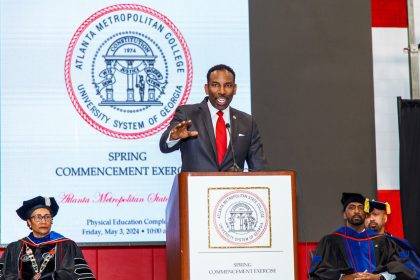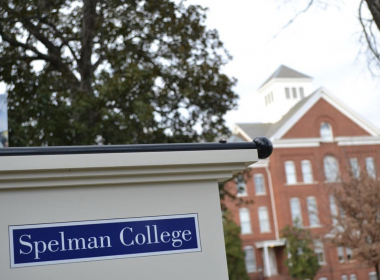
Atlanta Metropolitan State College is one of the 29 institutions in the University System of Georgia and one of three USG institutions (Georgia Institute of Technology, Georgia State University and AMSC) in the city of Atlanta. Ninety-five percent of the students who attend AMSC are Georgia and Atlanta residents.
The mission statement of an institution, its living philosophical biography, encapsulates what the institution holds to be true and outlines sound deliverables. Hence, “The mission of Atlanta Metropolitan State College as a unit of the university System of Georgia is to focus on excellence, where outstanding faculty members and committed staff teach and facilitate the successful academic matriculation and holistic development of students. The college offers an affordable liberal arts education and prepares students from a diverse urban community to function in a global society.”
Carrying out this mission in Atlanta in 2016 is a very noble cause, which gets right at the heart of God’s instruction for us to take care of the least of these. The unprecedented and legendary accomplishments of the city of Atlanta, of which we are all proud, would lead one to believe that the AMSC mission is a noble cause that is not difficult to carry out because of where the institution is located. Unfortunately, this is not the case. In reality, Atlanta is the tale of two cities because of the tremendous income and financial gap that exists between the haves and the have nots. The void between the haves and the have nots in Atlanta is wider than in any other city in the United States. The implications of this division are profound, particularly for students and their families from underserved and underrepresented backgrounds. A 2015 study by the Annie E. Casey foundation titled, “Changing the Odds, the Race for Results in Atlanta,” recently noted that the median income for African American families who are permanent residents of Atlanta is $29,605 per year, while the median income for a Caucasian family is $86,944 per year. “This disparity determines where families live, the educational opportunities families can benefit from and how the lack of educational opportunities can adversely impact the ability of poor children to move out of poverty.”
According to the Casey study, “Children’s success is strongly tied to their family’s stability and well-being, which, in turn, is affected by where they live. Children living in high-poverty areas — like many in the neighborhoods on Atlanta’s south side — frequently lack access to critical resources such as high-performing schools, quality medical care and safe outdoor spaces.” “The relationship between race and place is glaring in Atlanta. Ninety-four percent of White children live in low-poverty communities, compared to 20 percent of Black children and 57 percent of Latino children. Similarly 57 percent of African American children graduate from high school compared to 84 percent of Caucasian children.”
The Casey Study went on to point out that, “From the standpoint of education, the equation is simple: The more education you have, the more you earn — and the more likely you are to be able to get and keep a job that pays enough to support a family.” “In Atlanta, however, there is a notable difference in the quality of educational opportunities to which children have access, starting from their earliest years and continuing through high school.” This situation is even more discouraging at the collegiate level when one looks at baccalaureate degree attainment by income level. Data included in a New York Times report, (The Reproduction of Privilege) published March 12, 2012 clearly shows baccalaureate degree attainment for students in the top income quartile for the nation has increased from 40.2 percent to 82.4 percentsince 1970. However, for students in the bottom income quartile, baccalaureate degree attainment has increased only from 6.2 percent to 8.3 percent since 1970. This is an increase of only 2 percent in 45 years for students in this income level. This is devastating news for students from low income backgrounds nationally. Unfortunately, it is especially discouraging when we think about African American students in the Atlanta Public School system because more than 90 percent of the African American students in APS are on free and reduced lunch programs which means the overwhelming majority of APS students have been and remain in this low income quartile. Although income is not a single justification for low performance, it clearly sheds light on the daunting challenge the APS faces in educating students from homes where the median income for their families is $29,000 per year. Although assessments are made and conclusions often drawn about what transpires in the APS, a person would realistically have to live in a similar environment and under the financial constraints of families earning $29,000 annually to truly understand these circumstances.
Atlanta is a great city that we all love. The overwhelming majority of the recognition that the City enjoys is related to residents of the standard metropolitan statistical area and not the city itself which is made up mostly of permanent residents. When focusing on the permanent residents, the City needs what Dr. John Eaves, chairman of the Fulton County Board of Commissioners calls, “Infinite hope and meaningful educational action.” Dr. Eaves makes this very clear when he points out that “Seven out of 20 people in Atlanta are homeless. In terms of percentages, there are more people incarcerated in Atlanta than in New York City.” He goes on to point out that “More than 40,000 individuals are incarcerated each year in Fulton County and 90% of this group are African American males and 80 percent of this group do not have a high school education.” Much of the erosion in the social fabric of Atlanta is taking place because of a lack of education. Similarly, this lack of education is responsible for much of the social erosion in the community. The late educator Dr. Horace Mann was correct when he stated that “Education is the great equalizer.” Clearly more education must be acquired at both the secondary and collegiate levels by Atlanta residents to properly address both economic and opportunity divides.
The educational picture for permanent residents of our great city must change. More holistic, affordable, nurturing and intrusive educational opportunities must be provided for Atlanta residents. Atlanta Metropolitan State College decided to lead this initiative at the collegiate level by developing the aforementioned mission statement as it intensifies its work with the Atlanta Public School System to help more students finish high school ready and motivated to go to college. This was a calculated and deliberate decision by the leadership of AMSC to change the mission and trajectory of the institution to help close the educational void described above and to make both associate and baccalaureate degree attainment a reality for more residents of metropolitan Atlanta.
The character and culture of AMSC has changed in this regard and AMSC is now looked upon as a new beacon of hope for thousands of Atlanta citizens and their families. Many of these families had concluded that graduation from high school and college were not real possibilities. This is a challenge that AMSC is meeting because of its commitment to the citizens of Atlanta and its unique position as both an IMPACT and an OPPORTUNITY institution. AMSC is an impact institution because 95 percent of the students who attend are Atlanta and Georgia residents and, because it is the only public, associate and baccalaureate degree granting institution making this type of impact on the community in terms of accessibility. Students who graduate from AMSC take their skills and talents back to their communities. AMSC is an opportunity institution because it provides a holistic approach to high quality academic programs at a low cost. Seventy percent (70 percent) of the students who attend AMSC come from the Atlanta Public School System. It is also interesting to note that AMSC has the second highest graduation rate of the eleven institutions offering the associate degree in the access sector of the University System of Georgia. The importance of AMSC to the community has increased tremendously over the years because it is a high quality, low cost institution that is very accessible to the permanent residents of the Atlanta community. It is open seven days a week: from 6 a.m. until 10:45 p.m. Monday through Friday; all day Saturday and from 2 p.m. until 6 p.m. Sunday. It costs $3,800 per year for a full-time student to attend AMSC, making it the most inexpensive USG institution in the city. MARTA buses come right through the campus every 20 minutes all day making the campus accessible for students who need transportation.
The AMSC/APS collaborative initiative to educate more Atlanta residents is being carried out in multiple ways. Some of those ways include summer and weekend programs, administering a diagnostic form of the college admission test in the 10th grade to identify and address remediation at the secondary level through special courses and academic boot camps that are very successful. The special courses and boot camps significantly increase the number of students in APS and Fulton County who finish high school, college ready. The new mission of AMSC is clearly being well received by permanent residents of the City of Atlanta, so much so until the composition of the College has changed and the average age of students has dropped from 29 to a mode of 19. There are also opportunities for AMSC and our neighbor, Atlanta Technical College, to collaborate to provide more comprehensive access to both liberal arts and workforce development programs. Transfer agreements between the two institutions enables students completing associate degree programs at Atlanta Technical College in criminal justice and business administration to enter baccalaureate degree programs at Atlanta Metropolitan State College.
AMSC has also developed Dual Enrollment, Early College and Move-On-When-Ready programs to increase the number of students who finish high school with college credits. The Dual Enrollment Program has tripled in size over the past 24 months. Moreover, for the first time in May of 2016, several APS seniors enrolled in the Pre-Engineering Dual Enrollment Program at Maynard Jackson High School will graduate from high school with associate degrees in pre-engineering from Atlanta Metropolitan State College.
Consistent with its access mission, every student enrolling in AMSC is provided with a comprehensive array of support systems to facilitate their successful academic matriculation. These systems include; intrusive advisement, a First Year Experience Program, tutorial services, a required two-contact hour First Year Experience course, support services from the Center for Academic Success staffed with college faculty and student tutors, an Early Alert System for at-risk students and a Guided Pathways to Success (GPS) Program. The GPS Program is a series of practices, strategies and activities designed to help ensure student retention, academic progression and timely graduation. It is an initiative of Complete College America, which includes the State of Georgia. GPS provides intrusive guidance and structured roadmaps to keep students on track to degree completion without taking courses unnecessary for their major. Atlanta Metropolitan State College is among several University System of Georgia institutions selected to participate in piloting various GPS strategies.
The academic programs at AMSC are high in quality. The first two baccalaureate degree programs offered at AMSC were in the STEM (science, technology, engineering and math) disciplines which are housed in the Science, Mathematics and Health Professions Division. Ninety-five percent of the full-time faculty in those disciplines hold terminal degrees in their teaching disciplines from research institutions. Learning outcomes for the courses offered in this division are tied to national norms. Other baccalaureate degree programs are now also offered in Business Administration, Criminal Justice, Digital Media, Teacher Education and Organizational Leadership. Moreover, the size of the full-time faculty has increased from 43 to 80 over the past eight years. In addition, a minimum of 65 percentof the full-time faculty in the other three academic divisions, business and computer science, humanities and fine arts, and social sciences, hold terminal degrees in their teaching disciplines.
The holistic development of students is very important at AMSC. The College strives to insure that students not only go through college in a timely manner, but, that college also goes through them. The process provides the College with opportunities to assess and help students develop many of the soft skills that are missing but sorely needed by young professionals. This is accomplished through the planning and promotion of wholesome, high quality cultural, social, recreational and educational activities outside of the classroom. Additionally, AMSC students actively participate in highly competitive local and national summer science research programs. Throughout the year, many students gain valuable, real-life experiences and make connections in professional fields they are considering for career paths through internships in governmental, business and other organizations and agencies to provide important experiential learning opportunities. These activities are encouraged and supported by committed faculty members who are also engaged in scholarship and research across AMSC’s academic disciplines.
It costs less than $3,800 a year to take full load of classes (15 hours per semester) at Atlanta Metropolitan State College. This means that currently, a full-time student who successfully follows his or her academic program of study, and takes 15 hours of courses per semester, can complete an Associate Degree for less than $8,000 in terms of total tuition and fees and a bachelor’s degree for less $16,000 in terms of total tuition and fees. This also means that a Georgia resident who is college ready and eligible for a full PELL Grant which pays $5,750.00 per year, can attend AMSC with all tuition and fees paid by the PELL Grant. Moreover, students who are fully PELL eligible and receive a Hope Scholarship can use their PELL Grant dollars for their personal living expenses. Finally, students desiring a high quality, low cost, baccalaureate degree education from outstanding faculty members who utilize a holistic approach to education, in small classes where mentoring and tutoring opportunities are available, should give very serious consideration to enrolling in Atlanta Metropolitan State College.
New synergy and excitement exist between AMSC and the Atlanta Public School System. The “Back to School Bash” for APS was held on the AMSC campus in August where approximately 6,000 students and their parents visited the AMSC campus. New collaborative relationships with APS are being developed and more are envisioned. Closing the opportunity divide between the haves and have-nots in Atlanta is something that must and can be done and education is the only vehicle that can be used to help permanent residents of Atlanta reach this destination. Institutions like Atlanta Metropolitan State College must lead this endeavor.
AMSC is the place to BELIEVE, BEGIN and BECOME. For more information, visit the college website at www.atlm.edu.
–dr. gary mcgaha
Gary A. McGaha, Ph.D., is president of Atlanta Metropolitan State College and professor of political science.

















